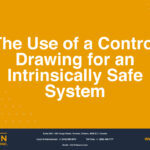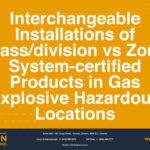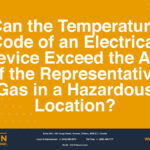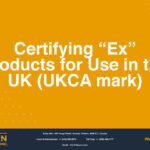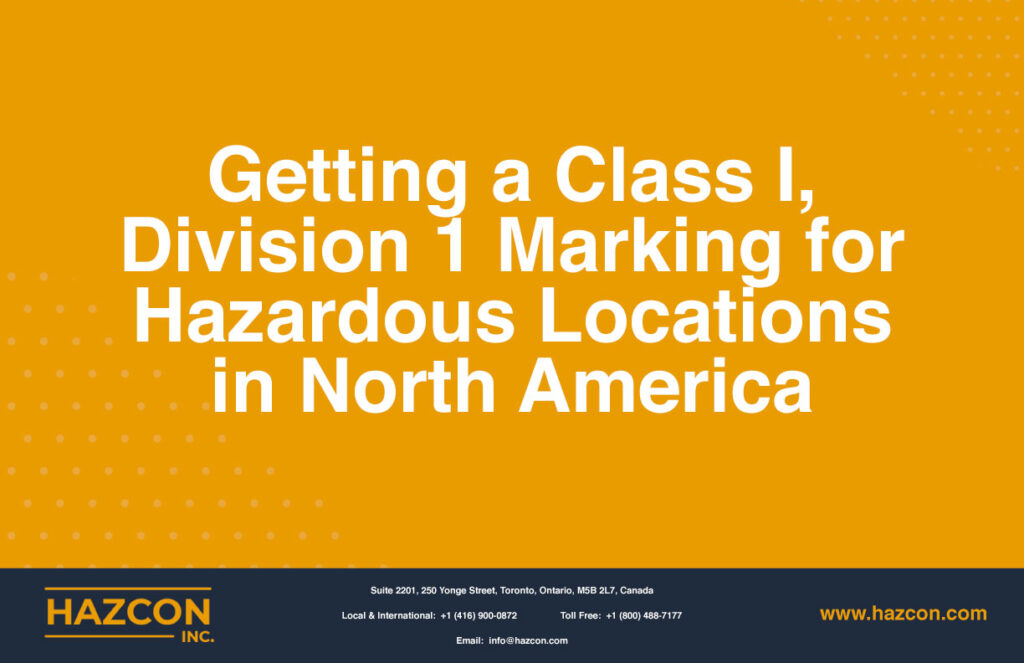
Getting a Class I, Division 1 Marking for Hazardous Locations in North America
Hazardous locations” are those in which there is or may be an ignitable concentration of flammable gas (including gas in vapour or liquid form), dust, or fibres, where a source of sufficient spark or thermal energy can cause an explosion. These locations are classified according, not just to the types of volatile substances present there, but also the likelihood of their being present at any given time.
Electrical equipment is still required in hazardous locations, even given the risks involved. Two of the features of electrical equipment that could contribute to the ignition of a flammable/ combustible gas in such environments are one or both of the following:
- Hot surfaces (all flammable/combustible gases have an ignition temperature)
- Electrical arcing/ sparks or mechanical sparks
In North America, all electrical products must first comply with what are called general safety (also known as ordinary location) Standards. Ordinary location requirements are specific for each type of electrical equipment and cover general safety requirements such as risk of electrical shock, fire hazards and injuries.
Class I refers to the presence (or possible presence) of hazardous substances that are flammable and/or combustible liquids, gases, or vapours (a location where there is a danger of explosion due to the presence of a flammable gas or vapour). Division 1 means a location where an explosive atmosphere exists continuously, for long periods or of time, or frequently.
Class I, Division 1 Protection techniques are typically provided through methods described as: containment, energy limitation, isolation of the ignition source from the explosive atmosphere. Methods must contain an internal explosion or eliminate one or more of the ingredients necessary for an explosion to take place (remove one of the three components of the fire triangle).
- Containment: This technique involves using an explosion-proof or ignition-proof enclosure as well as proper seals for cable and conduit to enclose any parts capable of igniting an explosive gas. Such an enclosure can withstand the pressure that results from an explosion. Therefore, if an explosion does occur inside the enclosure, it is prevented from spreading to the exterior of the device and the surrounding atmosphere. This technique, referred to as “explosion proof”.
- Energy Limitation: Not enough electrical or thermal energy can be released to cause ignition (there simply isn’t enough energy available for ignition). This type of protection applies to electrical devices in which the circuits and interconnecting wiring are incapable of causing an explosion. Division 1 products are protected by “intrinsically safe” technique.
- Hazard Isolation: This technique involves separating potential ignition sources from the explosive atmosphere. By pressurizing electrical equipment, for example, flammable gases are unable to enter enclosures in which electrical devices are located. The pressure of the protective gas is higher than the pressure of the surrounding atmosphere. Purged and pressurized enclosures operate by removing any residual gas or vapour from the enclosure before the power is turned on (the purge cycle) and by maintaining a positive pressure inside the enclosure in order to prevent the entrance of gas or vapour during operation (the pressurizing cycle).
For Class I, Division 1 products, there are several commonly used protection methods. Following are a few examples.
| Examples of Class I Division 1 Electrical Devices | Standards (General Safety Standards) | Method of Protection |
| General purpose equipment | CSA C22.2 No. 30 (Canada), UL 1203 (US) | Containment (explosion proof) |
| AC and DC electrical machines and generators | CSA C22.2 No. 145 (Canada), UL 674 (US) | Containment (explosion proof) |
| Luminaires | CSA C22.2 No. 137 (Canada), UL 844 (US) | Containment (explosion proof) |
| Sensors and measurement equipment with low power consumption | CSA C22.2 No. 60079-11 in conjunction with C22.2 No. 60079-0 (Canada), UL 60079-11 (US) | Energy Limitation (intrinsic safety) |
| Control panels and cabinets, gas analyzer equipment (electrical devices with a higher voltage and power rating) | NFPA 497 (Canada and the US) | Hazard isolation (purging and pressurization) |
In order to be approved for use in North America, electrical products manufactured anywhere in the world must be approved for use by a certifying body accredited by SCC in Canada and OSHA in the U.S. To obtain Class I Division 1 hazardous location markings, products must meet both ordinary location and hazardous location safety Standards. Approved products must bear the label of the certifying body (e.g., CSA or QPS) and markings that illustrate the characteristics of the product: its Class, Division, Group, Temperature Class and Method of Protection.
Request a Consultation
Complete the form below to get started.


